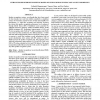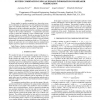ICMCS
2006
IEEE
15 years 6 months ago
2006
IEEE
In this paper, we present a robust text-independent speaker recognition system. The proposed system mainly includes an SNR-aware subspace-based enhancement technique and probabili...
125
Voted
ICMCS
2006
IEEE
15 years 6 months ago
2006
IEEE
Compressed-domain automatic speaker recognition is based on the analysis of the compressed parameters of speech coders. The objective is to perform low-complexity on-line speaker ...
102
click to vote
AVSS
2006
IEEE
15 years 6 months ago
2006
IEEE
We model the performance of a speaker recognition system used for surveillance to prioritize a large number of candidate speakers in search of a single target speaker. It is assum...
ICPR
2008
IEEE
15 years 7 months ago
2008
IEEE
Speaker recognition systems, even though they have been around for four decades, have not been widely considered as standalone systems for biometric security because of their unac...
110
Voted
ICPR
2008
IEEE
15 years 7 months ago
2008
IEEE
The effect of additive noise in a speaker recognition system is well known to be a crucial problem in real life applications. In a speaker recognition system, if the test utteranc...
85
Voted
ICASSP
2008
IEEE
15 years 7 months ago
2008
IEEE
Recent studies in speaker recognition have shown that scorelevel combination of subsystems can yield significant performance gains over individual subsystems. We explore the use ...
102
Voted
ICASSP
2008
IEEE
15 years 7 months ago
2008
IEEE
The performance of speaker recognition systems drop significantly under noisy conditions. To improve robustness, we have recently proposed novel auditory features and a robust spe...
ICASSP
2009
IEEE
15 years 7 months ago
2009
IEEE
This paper extends our previous work on feature transformationbased support vector machines for speaker recognition by proposing a joint MAP adaptation of feature transformation (...
126
click to vote
ICASSP
2009
IEEE
15 years 7 months ago
2009
IEEE
Maximum-Likelihod Linear Regression (MLLR) transform coefficients have shown to be useful features for text-independent speaker recognition systems. These use MLLR coefficients ...
106
Voted
ICASSP
2009
IEEE
15 years 7 months ago
2009
IEEE
The SRI speaker recognition system for the 2008 NIST speaker recognition evaluation (SRE) incorporates a variety of models and features, both cepstral and stylistic. We highlight ...


